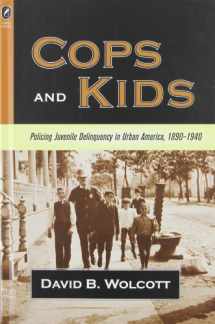
COPS AND KIDS: POLICING JUVENILE DELINQUENCY IN URBAN AMERICA, 1890-1940 (HISTORY CRIME & CRIMINAL JUS)
ISBN-13:
9780814210024
ISBN-10:
0814210023
Edition:
1
Author:
DAVID B WOLCOTT
Publication date:
2005
Publisher:
Ohio State University Press
Format:
Hardcover
280 pages
Category:
Law Enforcement
,
Criminal Law
,
Criminology
,
Social Sciences
,
Children's Studies
FREE US shipping
on ALL non-marketplace orders
Marketplace
from $12.96
USD
Marketplace offers
Seller
Condition
Note
Seller
Condition
Used - Good
Ex-library copy with usual markings.
Book details
ISBN-13:
9780814210024
ISBN-10:
0814210023
Edition:
1
Author:
DAVID B WOLCOTT
Publication date:
2005
Publisher:
Ohio State University Press
Format:
Hardcover
280 pages
Category:
Law Enforcement
,
Criminal Law
,
Criminology
,
Social Sciences
,
Children's Studies
Summary
COPS AND KIDS: POLICING JUVENILE DELINQUENCY IN URBAN AMERICA, 1890-1940 (HISTORY CRIME & CRIMINAL JUS) (ISBN-13: 9780814210024 and ISBN-10: 0814210023), written by authors
DAVID B WOLCOTT, was published by Ohio State University Press in 2005.
With an overall rating of 3.7 stars, it's a notable title among other
Law Enforcement
(Criminal Law, Criminology, Social Sciences, Children's Studies) books. You can easily purchase or rent COPS AND KIDS: POLICING JUVENILE DELINQUENCY IN URBAN AMERICA, 1890-1940 (HISTORY CRIME & CRIMINAL JUS) (Hardcover) from BooksRun,
along with many other new and used
Law Enforcement
books
and textbooks.
And, if you're looking to sell your copy, our current buyback offer is $0.15.
Description
Juvenile courts were established in the early twentieth century with the ideal of saving young offenders from "delinquency." Many kids, however, never made it to juvenile court. Their cases were decided by a different agency—the police. Cops and Kids analyzes how police regulated juvenile behavior in turn-of-the-century America. Focusing on Los Angeles, Chicago, and Detroit, it examines how police saw their mission, how they dealt with public demands, and how they coped daily with kids. Whereas most scholarship in the field of delinquency has focused on progressive-era reformers who created a separate juvenile justice system, David B. Wolcott’s study looks instead at the complicated, sometimes coercive, relationship between police officers and young offenders. Indeed, Wolcott argues, police officers used their authority in a variety of ways to influence boys’ and girls’ behavior. Prior to the creation of juvenile courts, police officers often disciplined kids by warning and releasing them, keeping them out of courts. Establishing separate juvenile courts, however, encouraged the police to cast a wider net, pulling more young offenders into the new system. While some departments embraced "child-friendly" approaches to policing, others clung to rough-and-tumble methods. By the 1920s and 1930s, many police departments developed new strategies that combined progressive initiatives with tougher law enforcement targeted specifically at growing minority populations. Cops and Kids illuminates conflicts between reformers and police over the practice of juvenile justice and sheds new light on the origins of lasting tensions between America’s police and urban communities.


We would LOVE it if you could help us and other readers by reviewing the book
Book review

Congratulations! We have received your book review.
{user}
{createdAt}
by {truncated_author}


